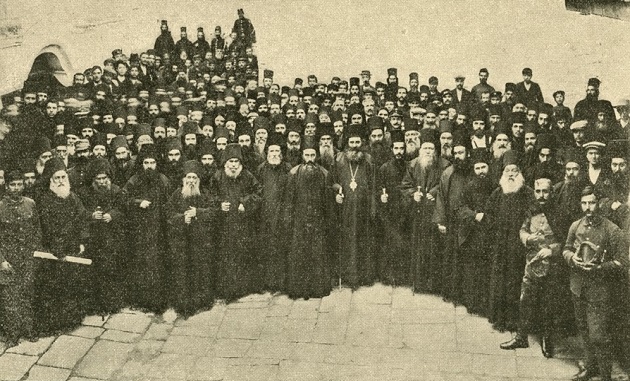Greek Monasticism in the 19th Century [1] (Protopresbyter Georgios Metallinos)
30 Οκτωβρίου 2017
During the nineteenth century the newly created Greek State attempted to become European, focused on its progress and modernization. Of course, this tactic had a catalytic influence on the direction of the Church and especially on monasticism.
Our text focuses on some basic ideas, within the framework of a variety of observations, and does not make the claim of being complete. Furthermore, despite the plethora of studies of monasticism[i] covering the post-revolutionary years, the absence in the bibliography of a comprehensive-systematic study of the developmental path of the monastic life, from the official declaration of Greek Autocephaly (1850) up to our era, was evident.[ii]
The New Spirit and Climate
Already, from the end of the eighteenth century, a new world began to introduce itself to the east. This world was a product of the ideological and political processes and developments of Western Europe; and through those who bore its spirit, sought to reorient and reshape Roman-Orthodox society. It was the Enlightenment, the new general approach to life and the radical redefining of all expressions of life, which infused the Orthodox conscience with elements that went against its identity (religious indifference, atheistic tendencies, societal isolation).[iii] The new European humanism extended its influence to the ranks of the common man, through the continuous westernizing education, inspired by the followers and fans of Adamantios Korais, chief among whom were Theoklitos Farmakidis and Theophilus Kairi.
The spirit of the Enlightenment, bound together with secularization, caused a break in the traditional spiritual and social relationships, and offered new ones, grounded in the new mentality, which also inspired a new anthropology and soteriology, according to which the intellect takes the place of grace, and absolutized worldly knowledge distances itself, at its root, from the search for the uncreated. Humanism will turn out to be a new religion for the man of the nineteenth century. Every sense of a law of God, and of God at the center of life was rejected even when, for a variety of reasons, religion was not yet discarded. While the place of rationalism defined the new humanistic model in Orthodox society, the spirit of pietism, as a wise religiosity, asserted its own anthropological model, which corresponded to the social conventions of a religious urban society.[iv] This spirit, which was significantly strengthened by the presence of, and action in the area of, the ethnarchy of western missionaries,[v] was instilled in groups seeking new forms and means for their missionary work, and who began to copy the missionaries.
The state’s systematic turn to western models strengthened the syndrome of Europeanization, expressed in the principle Korais set forth, of “emptying out,” [μετακένωση] imposed through the intellect and the political world, and as a foundation for the depreciation of the tradition of the Greek people for the sake of their modernization and progress – a permanent inoculation, in the plans of Greek politics since then. In addition, the Greek Autocephaly, an ecclesiastical event of great ecclesiastical as well as political importance,[vi] was the high point of what was imposed from without: the westernized redefinition of Greece’s entire internal reality. However, the things that were imposed on the (so-called) free state passed on vibrations that were subversive for the tradition to the entire Greek people, re-energizing as a catalyst there and influencing the other ethnic Orthodox populations in a similar fashion.
The Attempt to Westernize the Church
However, as we have mentioned elsewhere,[vii] the westernization of the state that was pursued was completely impossible without the westernization of the Church, which radically differentiated the Orthodox nationalities of the ethnarchy from the cultural tradition of Europe. The “scheming” (to use the precise word, which was proven to be accurate by Kosmas Phlamiatos) against Orthodoxy centered on monasticism, the place where the authentic continuation of the structure and way of ecclesiastical being exists.[viii] The extent of the instituted erosion was revealed by the Synod’s “official ecclesiastical” participation in the dissolution of the holy monasteries, indicative of the spirit of self-destruction that had ruled the ecclesiastical hierarchy from 1833 on.[ix] Archimandrite Theoklitos Farmakidis, secretary of the Holy Synod, as an active member of the seven-member board, introduced the “Exposition” (in March 1833) regarding the ecclesiastical questions where, according to the most important theologian of the nineteenth century, the Protopresbyter Constantine Oikonomos, “the monks were the final victims of the Exposition.” The board’s “Exposition” would be put into effect by the Regent (Mauer), despite the fact that many articles of the Exposition violated the Orthodox canonical order, which had been passed down from the Ecumenical Synods. The traditionalist Protopresbyter Constantine Oikonomos described the decisions in question as follows: the sudden transformation of all of the monasteries into coenobiums, was “the initial action to lead to the dissolution of the monasteries.” The prohibition against coenobiums consisting of less than thirty monastics was the “second way to dissolve the monasteries.” And finally, the exclusion of anyone under thirty years of age was the “third way of bringing about the destruction of the monastic culture.”[x]
The position of the ecclesiastical hierarchy before the spiritual objectives of St. Nectarios,[xi] the great ascetic of the nineteenth century, reveals a continuous behavior that exuded from the mindset of those who followed Farmakidis.
[Το Be Continued]





